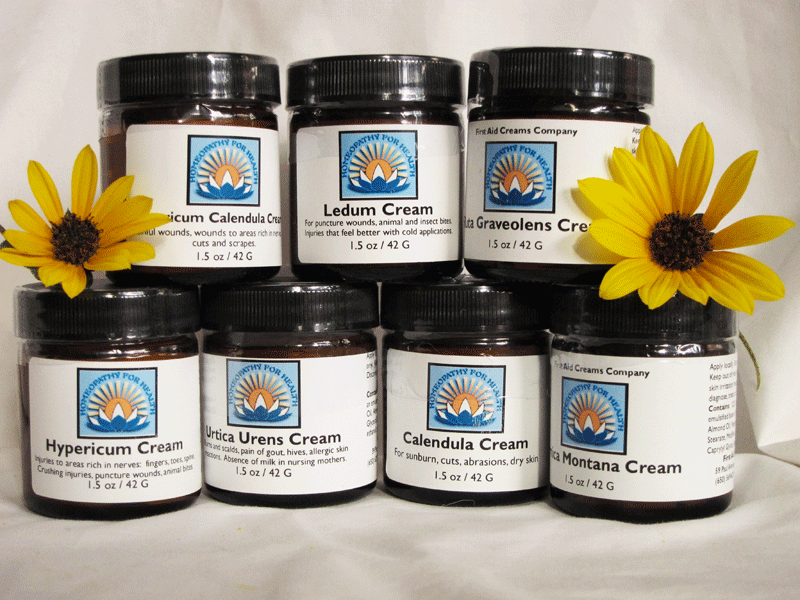BUY CALENDULA OFFICINALIS CREAM
Learn About Calendula Officinalis
Calendula Officinalis – Wound Healing
Calendula officinalis, the yellow marigold, is another member of the Compositae family, like our friends, Arnica montana and Bellis perennis, and is a remedy that has as many wonderful uses. I would make sure that all mothers and fathers were familiar with this remedy, if I could. This remedy is truly a friend to children and everyone else. Here is a list of some of its uses.
Some features of Calendula officinalis:
1) For falls, lacerated wounds, and septic wounds. Calendula offic
Calendula officinalis is listed in my repertory for painful wounds, wounds that do not heal, chronic effects from wounds, wounds that tend to break open and heal again, dissecting wounds, festering wounds, gangrenous wounds, gaping wounds, inflammation of wounds, neglected wounds, suppurating wounds, and lacerated, torn or ragged wounds. The herbalist Sharol Marie Tilgner in her new book Herbal Medicine from the Heart of the Earth, says that Calendula officinalis is “her favorite topical first aid treatment for wounds. “
As you can see Calendula officinalis and wounds are best buddies. Calendula officinalis prevents too early scab formation at the wound site, and stimulates the growth of epithelial cells. It keeps the healing agents actively working on the site until the wound is healed. This helps to inhibit scars and infections. Avoid frequent changing of the bandage, because this interferes with the healing process, and causes too early scab formation, which can result in scarring. Remember when cleaning a wound always clean outwardly away from the wound.
2) Gunshot wounds. Calendula officinalis prevents suppuration and infection of gunshot wounds. I would hope that the hospital staff would give you an internal dose of Calendula officinalis for this, as well as apply it topically to the wound. (The images of gunshot wounds were too horrific to post, so I posted the image of a gun instead – the cause of much suffering).

4) Calendula officinalis promotes healthy granulation of the tissues and prevents peritonitis after surgery. I always recommend my clients who are going through surgery to take Calendula officinalis 30C or 200C after they have taken their Arnica montana, Bellis perennis, Staphysagria, Hypericum perforatum or other indicated pain remedies and healing agents to help complete the healing of the wound and prevent infection. Calendula officinalis helps prevent keloid formation. The remedy is beneficial after Caesarean operations. I cannot imagine going through a surgery without having this remedy as insurance.

5) Calendula officinalis promotes healing after dental work. I recommend my clients to apply a compress of a few drops of Calendula officinalis tincture dissolved in warm water to the socket of the tooth that has been removed in dental extractions, or to the site where dental work has been done to promote healing, prevent infection, and bring soothing relief. It also helps to stop bleeding. Many other remedies can be indispensable to help with dental surgery recovery, so please work with a homeopath alongside your dentist when you are having major dental surgery.

7) Calendula officinalis helps with the maturation and healing of abscesses.
8) Calendula officinalis helps to relieve the pain and fever of carbuncles.
9) In Clarke’s dictionary, I read that Calendula officinalis tincture applied on a hot compress, can help in pneumonia and other internal inflammations.
10) Calendula officinalis can help soothe the skin following sunburns.
11) Calendula officinalis is also listed as an antitumor remedy, and is listed for tumors of the breast, uterus, fibromas, ulcerated tumors, benign tumors and neuromas
12) Calendula officinalis is antiseptic, anti-inflammatory, a demulcent “a bland, often mucilaginous or oily agent that soothes and heals mucous membranes by forming a protective coating over the irritated or inflamed mucosa,” (from Dr. Tilgner).
Contraindications: According to Dr. Tilgner, the herbalist the herb should not be taken orally during pregnancy, because it is an abortificant and emmenagogue (it can bring on the menstruation). It is not, however, listed as an abortificant in the homeopathic literature. Occasional use of the cream topically should be safe during pregnancy.
Calendula officinalis is one of nature’s wonderful gifts for easing pain and healing. This is as essential in the family’s medicine chest as a hammer is in the family toolbox.
Directions for use: Apply locally. Rub in well. For external use only. Keep out of reach of children. Discontinue use if skin irritation results. The creams are not intended to prevent, diagnose, treat, or cure any disease.
How Often to Use the Creams:
Some people are helped by a single application of the needed cream. Other people may need to apply the creams frequently. Here is a good guide on how to use the creams: if the affected part feels much better or significantly worse after an application of the cream, that is a sign that you need to pause from it and wait. If the part felt better do not reapply until the symptoms that were relieved start bothering you again, or you feel there has been a relapse.
If the part felt significantly worse after an application of the cream it means that the cream has found the symptom and it is working on it. With homeopathic remedies and creams, there is often an intensification of the symptoms (or aggravation) where the remedy finds the symptom and tries to push it on through. The medicinal reaction has to be stronger than the patient’s own symptoms in order to overcome the patient’s symptoms.
After an aggravation of symptoms, an amelioration, or gradual improvement of symptoms should follow. You do not need to reapply the cream until the process has gone full circle – that is the aggravation has been followed by an amelioration, and then a return of symptoms, indicating that it is time to redose or reapply the cream.
If the patient does not experience a strong aggravation or strong amelioration after applying the creams, then they can continue to apply them one, two, three or even four times a day, until they experience either the aggravation or amelioration of the symptoms, indicating that it is time to stop. If there is no response, the cream may not be homeopathic to the case. At this point it is advisable to consult a homeopath for further guidance. I hope that this will bring some clarity as to how to use the creams.


